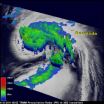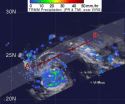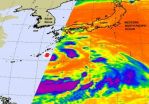(Press-News.org)
VIDEO:
This animation of NOAA's GOES-13 satellite observations from Sept. 6 at 8:45 a.m. EDT through Sept. 16 at 7:45 a.m. EDT shows the movement of Hurricane Katia followed by Tropical...
Click here for more information.
Hurricane Maria joins twelve other hurricanes on record to make landfall in Newfoundland, Canada, and NASA satellite imagery revealed its inner strength.
The Tropical Rainfall Measuring Mission (TRMM) satellite passed over Hurricane Maria on Sept. 15 and the Precipitation Radar instrument revealed "hot towers," or towering cumulonimbus cumulus clouds that indicated a lot of strength in the storm. Hot towers penetrate the tropopause. They are called hot towers" because of the large amount of latent heat released as water vapor condenses into liquid and freezes into ice.
At NASA's Goddard Space Flight Center in Greenbelt, Md., Hal Pierce of the TRMM science team created a 3-D image from TRMM data. The 3-D image showed the hot towers around Maria's center had reached heights of over 11km (6.8 miles). It also showed powerful storms in feeder bands on Maria's western side were over 12km (7.5 miles) high, containing heavy rainfall (falling at 2 inches/50 mm per hour). Earlier NASA studies concluded that whenever hot towers are seen around the center of a tropical cyclone, the storm will likely intensify within six hours. In addition to that power within Maria, she's also moving very fast through the Atlantic which is helping keep her composure, according to the National Hurricane Center.
Another NASA satellite provided cloud temperatures, which relate to cloud height and strength. The Atmospheric Infrared Sounder (AIRS) instrument aboard NASA's Aqua satellite captured an infrared image that revealed strong convection (rapidly rising air that forms thunderstorms) and the strong thunderstorms around Maria's center, matching the TRMM satellite data. Those areas had cloud-top temperatures as cold as -63F/-52C. Cloud-top temperatures are important because they tell forecasters how high thunderstorms are, and the higher the thunderstorm, the colder the cloud tops and the more powerful the thunderstorms.
AIRS infrared image of Hurricane Maria was taken on Sept. 15 at 1:35 p.m. EDT and showed the long extent of Maria's clouds stretching from Florida to Nova Scotia, Canada. On Sept. 16, AIRS data showed the cloud top temperatures were warming, indicating that cloud heights are falling, and Maria had less energy (convection) than it did 24 hours before.
Since records have been kept in 1775, there have been 12 other recorded hurricanes to make landfall in Newfoundland. Tropical cyclones hit Newfoundland in 1775, 1866, 1873, 1886, 1891, 1893, 1939, 1958, 1995, 2000, 2002, and most recently, Hurricane Igor on Sept. 21, 2010. Igor struck Cape Race, Newfoundland as a category one hurricane with maximum sustained winds near 80 mph (120 kmh) and higher gusts. Igor was called the worst hurricane to hit Newfoundland in a century. Maria is the 13th storm to make landfall there.
Usually, Canada is hit with weak tropical cyclones because of the cool waters offshore. However, some storms have maintained hurricane strength because the warm waters of the Gulf Stream extend relatively close to eastern Canada.
Today, however, Maria is maintaining strength and has prompted a hurricane warning for Newfoundland from Arnolds Cove to Brigus south. A tropical storm warning is in effect for Newfoundland from Stones Cove to Arnolds Cove and from Brigus south to Charlottetown.
At 11 a.m. EDT, Hurricane Maria had maximum sustained winds near 75 mph (120 kmh). She was located about 210 miles (340 km) southwest of Cape Race, Newfoundland near 44.6 North and 56.3 West. Maria was speeding to the northeast at 52 mph (83 kmh) and had a minimum central pressure of 983 millibars. Tropical storm conditions are expected to continue across southeastern Newfoundland tonight, according to the National Hurricane Center. Hurricane conditions are expected by mid-day today. However, the National Hurricane Center noted that hurricane force winds are likely only occurring to the southeast of the center and could remain offshore if the center moves to the right of the forecast track.
Maria is already beginning to transition into an extra-tropical cyclone, and infrared imagery from NASA's AIRS instrument shows that all of the strong convection and strongest thunderstorms have moved north of the center.
Rainfall is expected to be between 1 and 3 inches, and coastal flooding is expected near and to the east of where Maria makes landfall. After passing Newfoundland, Maria will move into cooler waters and weaken over the weekend.
INFORMATION:
NASA sees power within hurricane Maria as it heads for a landfall in Newfoundland
2011-09-19
ELSE PRESS RELEASES FROM THIS DATE:
NASA's TRMM satellite sees moderate rainfall Tropical Storm Sonca
2011-09-19
When the Tropical Rainfall Measuring Mission (TRMM) satellite flew over Tropical Storm Sonca on Friday, Sept. 16 it found moderate rainfall mostly on the southern side of the storm. Chichi Jima can expect some of that rainfall over the weekend as Sonca passes east of the island.
TRMM passed over Tropical Storm Sonca and its precipitation radar instrument saw moderate rainfall occurring mostly on the southern side of the storm, while light-to-moderate rainfall was occurring throughout the storm. The southern edge of the storm had rainfall rates between .78 to 1.57 inches ...
Infrared satellite data shows Tropical Storm Roke strengthening
2011-09-19
Tropical Storm Roke has changed in size and is starting to change in strength. Roke appears to be consolidating in infrared imagery from NASA's Aqua satellite.
Roke began its life as a monsoon depression with a large low-level circulation center that over time consolidated and organized. The eastern half of Tropical Storm Roke was seen in an infrared image from NASA's Aqua satellite AIRS (Atmospheric Infrared Sounder) on Sept. 15, and it showed a more consolidated center with strong convection and very cold cloud-top temperatures.
Cloud-top temperatures are important ...
Study suggests possible link between two Type 2 diabetes drugs and pancreatic cancer
2011-09-19
Two newer drugs used to treat Type 2 diabetes could be linked to a significantly increased risk of developing pancreatitis and pancreatic cancer, and one could also be linked to an increased risk of thyroid cancer, according to a new UCLA study.
Researchers from the Larry L. Hillblom Islet Research Center at UCLA examined the U.S. Food and Drug Administration's database for adverse events reported between 2004 and 2009 among patients using the drugs sitagliptin and exenatide. They found a six-fold increase in the odds ratio for reported cases of pancreatitis with these ...
People born after World War II are more likely to binge drink and develop alcohol disorders
2011-09-19
September 15, 2011 --. In a review of 31 peer-reviewed and published studies, researchers at Columbia University's Mailman School of Public Health looked generational and gender differences in alcohol consumption, alcohol disorders, and mortality. Findings indicate that people born after World War II are more likely to binge drink and develop alcohol use disorders. Researchers also found that the gender gap in alcoholism and problem drinking is narrowing in many countries.
Findings will be published in the December 2011 issue of Alcoholism: Clinical & Experimental Research ...
Autism, intellectual disabilities related to parental age, education and ethnicity, not income
2011-09-19
SALT LAKE CITY – New research from the University of Utah in collaboration with the Utah Department of Health (UDOH) shows that the presence or absence of intellectual disability (ID) and autism spectrum disorders (ASD) varies with risk factors such as gender, parental age, maternal ethnicity, and maternal level of education. The study, published Sept. 15, 2011, in Autism Research, also shows that household income level has no association with either ID or ASD, in contrast to what other studies have suggested.
ASDs are a group of childhood neurodevelopmental disorders ...
Good news for rural stroke patients: Virtual stroke care appears cost-effective
2011-09-19
ST. PAUL, Minn. – In a first of its kind study, researchers have found that using two way audio-video telemedicine to deliver stroke care, also known as telestroke, appears to be cost-effective for rural hospitals that don't have an around-the-clock neurologist, or stroke expert, on staff. The research is published in the September 14, 2011, online issue of Neurology®, the medical journal of the American Academy of Neurology.
"In an era of spiraling health care costs, our findings give critical information to medical policy makers," said Jennifer J. Majersik, MD, MS, ...
Low-fat yogurt intake when pregnant may lead to child asthma and hay fever
2011-09-19
Amsterdam, The Netherlands: Eating low-fat yoghurt whilst pregnant can increase the risk of your child developing asthma and allergic rhinitis (hay fever), according to recent findings.
The study will be presented at the European Respiratory Society's (ERS) Annual Congress in Amsterdam on 25 September 2011. All the abstracts for the ERS Congress will be publicly available online from today (17 September 2011).
The study aimed to assess whether fatty acids found in dairy products could protect against the development of allergic diseases in children.
The researchers ...
Crystal structure shows how motor protein works
2011-09-19
The crystal structure of the dynamin protein — one of the molecular machines that makes cells work — has been revealed, bringing insights into a class of molecules with a wide influence on health and disease.
"It's a really cool structure," said Jodi Nunnari, professor and chair of molecular and cellular biology at UC Davis and senior author of the paper, to be published Sept. 18 in the journal Nature. "This is a really important class of molecules for regulating membrane dynamics."
The detailed structure reveals exactly how the dynamin protein can form large assemblies ...
Osteoporosis Phase III data at 2011 ASBMR Show oral calcitonin tablet is safe and effective
2011-09-19
SAN DIEGO, CA and PHILADELPHIA, PA – September 18, 2011 —Tarsa Therapeutics today presented positive safety and efficacy data from its Phase III ORACAL trial of OSTORA™, the company's oral recombinant salmon calcitonin tablet in development for the treatment of postmenopausal osteoporosis. These data were presented at the American Society for Bone and Mineral Research 2011 Annual Meeting by ORACAL investigator Neil Binkley, MD, who is an Associate Professor of Endocrinology and Geriatrics at the University of Wisconsin School of Medicine and Public Health in Madison, ...
Why carbon nanotubes spell trouble for cells
2011-09-19
VIDEO:
Receptors on the cell's surface crowd around the nanotube, effectively standing it upright. The cell mistakes the tube for a sphere and begins to engulf it.
Click here for more information.
PROVIDENCE, R.I. [Brown University] — It's been long known that asbestos spells trouble for human cells. Scientists have seen cells stabbed with spiky, long asbestos fibers, and the image is gory: Part of the fiber is protruding from the cell, like a quivering arrow that's found ...



